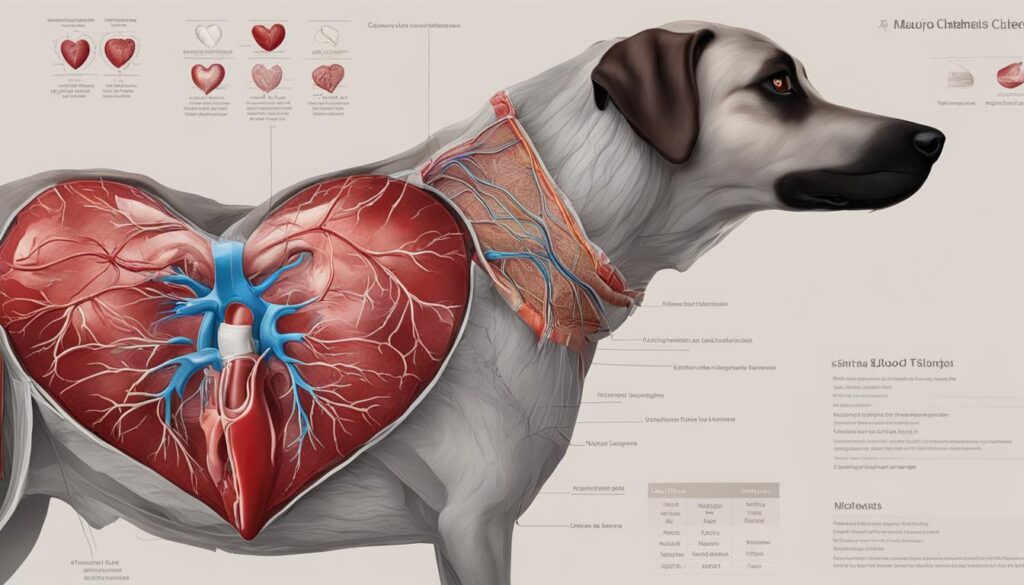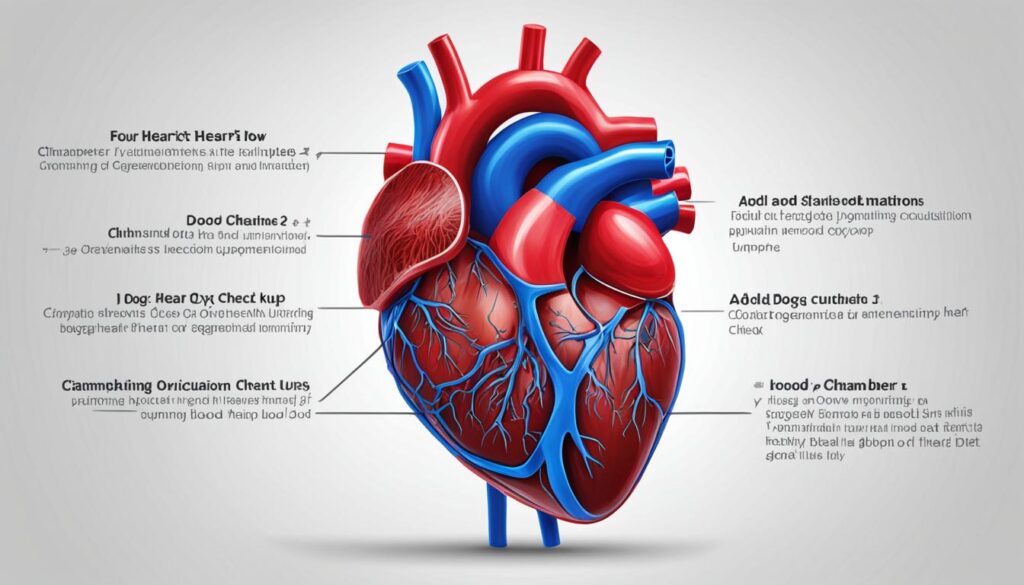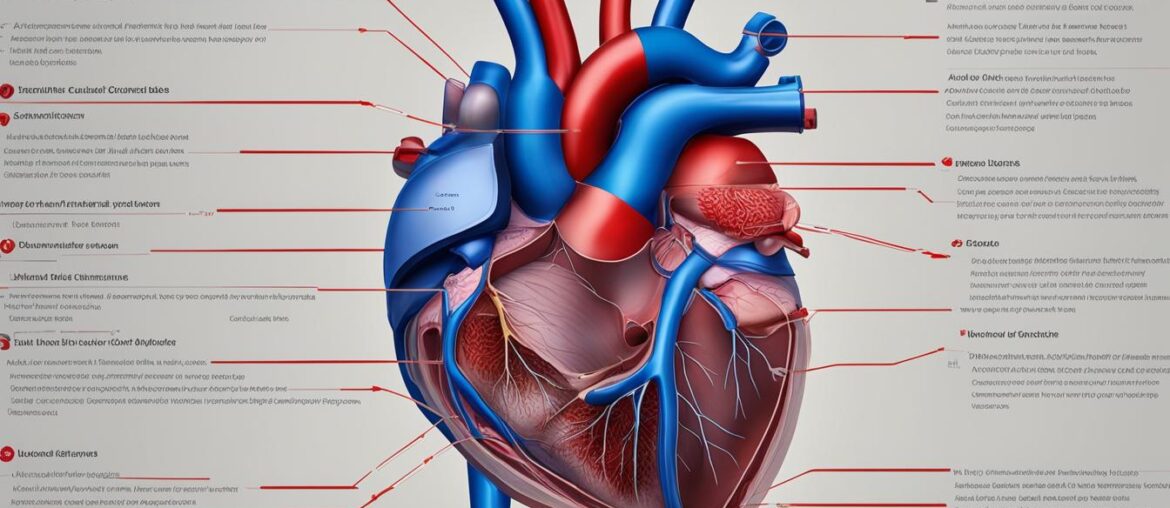As a pet owner, it’s essential to have a thorough understanding of your dog’s anatomy and physiology. One vital organ that plays a crucial role in your dog’s overall health is the heart. By knowing the location and function of your dog’s heart, you can better monitor their cardiovascular health and take necessary measures to ensure your beloved canine companion stays in optimal shape.
The canine cardiovascular system, including the heart, is a complex network of blood vessels, veins, arteries, and capillaries that work together to deliver oxygenated blood to the organs and tissues throughout the body. By familiarizing yourself with the structure and function of a dog’s heart, you can proactively monitor for any signs of potential heart issues and seek appropriate veterinary care.
In this article, we will explore the location of a dog’s heart within the body, the anatomy of the heart, how to assess the heart rate and rhythm, and common heart conditions in dogs. By the end, you’ll have a comprehensive understanding of your dog’s heart and what you can do to support their cardiac health.
Key Takeaways:
- Understanding the location and function of your dog’s heart is crucial for monitoring their cardiovascular health.
- The canine cardiovascular system is a complex network of blood vessels, veins, arteries, and capillaries.
- Familiarize yourself with the anatomy of a dog’s heart to proactively monitor for potential heart issues.
- Regularly check your dog’s heart rate and rhythm to identify any irregularities.
- Common heart conditions in dogs include congenital heart disease, heartworm disease, valvular heart disease, and dilated cardiomyopathy (DCM).
Where Is a Dog’s Heart Located in the Body?

A dog’s heart is a vital organ that ensures proper circulation of blood throughout the body. Understanding its location is essential for recognizing potential health issues and providing appropriate care for your furry friend.
The typical placement of a dog’s heart is in the middle of the chest, between the lungs. While the exact position may vary slightly depending on the breed, it is generally situated in an upright position.
In barrel-chested breeds, like French Bulldogs or English Bulldogs, the round shape of their chest may affect the position of the heart. On the other hand, deep-chested breeds, such as Whippets, Dobermans, or Boxers, tend to have a more upright heart placement.
Knowing the precise location of your dog’s heart is not only beneficial in CPR situations but also helps raise overall awareness of the organ’s placement and function within the body.
Observing the location of a dog’s heart is not difficult, but it can be crucial in understanding their anatomy and maintaining their well-being.
Dog Heart Anatomy: A Closer Look

In order to understand the function and potential health implications of a dog’s heart, it is important to take a closer look at its anatomy. The canine heart is a four-chambered organ shaped like an oval, and it is a vital part of the complex cardiovascular system in dogs.
The canine cardiovascular system includes blood vessels, veins, arteries, and capillaries, all working together to ensure the proper circulation of blood throughout the body. The heart plays a central role in this system, serving as the main pump for blood circulation.
The dog’s heart is divided into two sides – the right side and the left side. The right side is responsible for pumping deoxygenated blood to the lungs, where it gets oxygenated, while the left side pumps oxygenated blood to the rest of the body, delivering essential nutrients and removing waste products.
The size of a dog’s heart can vary depending on its breed and size. Generally, larger dogs have larger hearts to accommodate their body’s needs. Understanding the intricate structure of a dog’s heart is crucial for comprehending its function and recognizing potential health issues.
To visualize the anatomy of a dog’s heart, refer to the diagram above. It depicts the four chambers, the major blood vessels, and the intricate network of valves that regulate blood flow.
In conclusion, a dog’s heart is a remarkable organ that is vital for its overall health and well-being. By understanding the intricacies of its anatomy, pet owners can better appreciate the functions of this essential organ and take proactive measures to care for their furry companions’ cardiovascular health.
How Do You Feel a Dog’s Heart?

To feel a dog’s heart, place your hand on their chest just behind their elbows. You will be able to feel the rhythmic thumping of their heart. This method is useful for determining if the heart is beating normally and if there are any irregularities. Monitoring a dog’s heart rate can also be done by feeling for their pulse at specific points on their body, such as the femoral artery located on the inner thigh or above the metacarpal pad on the front paw.
Feeling a dog’s heart and checking their heart rate are important ways to stay informed about their cardiovascular health. Regularly monitoring a dog’s heart rate and being aware of any changes can help in identifying potential heart issues.
Image shows a person placing their hand on a dog’s chest to feel its heart.
How Do You Listen to a Dog’s Heart?
Listening to a dog’s heart can provide valuable insight into its overall health. By understanding the heart sounds and rhythm, you can detect any irregularities or potential issues. Here’s a step-by-step guide on how to listen to a dog’s heart:
- Find a quiet place: Choose a calm and quiet environment where you can focus on listening to the heart sounds.
- Position the dog comfortably: Allow the dog to relax and get into a comfortable position, either lying down or sitting still.
- Use a stethoscope: Place the stethoscope on your ears and gently press the diaphragm against the dog’s chest, just behind the front leg on the left side.
- Listen for the heart sounds: Pay attention to the normal heart sounds, which are commonly described as “lub-dub.” The first sound, “lub,” is the closing of the heart valves, while the second sound, “dub,” is the opening of the valves.
- Count the heart rate: As you listen to the heart sounds, count the number of beats per minute. A normal resting heart rate for dogs ranges between 60 to 140 beats per minute, depending on the size and breed.
- Observe for irregularities: Be vigilant for any irregular heart sounds, such as murmurs or arrhythmias. These may indicate potential heart issues that require further investigation by a veterinarian.
Listening to a dog’s heart is an essential component of a comprehensive physical examination and can provide valuable information about their cardiovascular health. Regular monitoring and early detection of any abnormalities can help ensure timely intervention and appropriate treatment if necessary.
Remember to consult a veterinarian for any concerns or questions regarding your dog’s heart health.
How Can You Perform CPR on a Dog?
CPR, or cardiopulmonary resuscitation, is a crucial life-saving procedure that every dog owner should be familiar with. In certain emergency situations where a dog is unresponsive and not breathing, performing CPR promptly can make a significant difference in their chances of survival.
To perform CPR on a dog, follow these steps:
- Step 1: Assess the situation – Ensure that the dog is unresponsive and not breathing. Look for signs of breathing such as chest movements or fogging of a mirror placed in front of the nose.
- Step 2: Position the dog – Lay the dog on their right side on a firm surface. Ensure their head and neck are in a natural position.
- Step 3: Begin chest compressions – Place one hand on the widest part of the rib cage, slightly behind the dog’s elbows. Interlock your other hand over the first and apply firm and rhythmic pressure. Compress the chest approximately ⅓ to ½ of its width. Perform 100 to 120 compressions per minute.
- Step 4: Provide artificial respiration – After every 30 compressions, give two quick breaths. Gently close the dog’s mouth, ensuring their airway is open, and place your mouth over their nostrils. Blow just enough to see the dog’s chest rise.
- Step 5: Continue compressions and breaths – Maintain a ratio of 30 compressions to 2 breaths. Repeat this process until the dog starts breathing on their own or professional veterinary care is obtained.
Remember, performing CPR on a dog is an emergency intervention and should be followed by immediate veterinary care. It is crucial to remain calm and focused during the procedure. Seeking professional help is essential for accurate diagnosis and further treatment.
Signs Indicating the Need for CPR in Dogs
Source: American Red Cross, Canine CPR and First Aid Course
| Signs Indicating the Need for CPR | Action |
|---|---|
| No heartbeat or pulse | Begin chest compressions |
| No breathing or gasping for air | Provide artificial respiration |
| Unconsciousness | Perform CPR and seek veterinary care |
By learning and understanding how to perform CPR on a dog, you can potentially save their life in critical situations. However, always remember the importance of professional veterinary care and consult a veterinarian after performing CPR. Your quick actions combined with professional expertise can greatly increase the chances of a positive outcome.
How Do I Know If My Dog Has Heart Pain?

Heart pain or discomfort in dogs can be challenging to identify since they cannot directly communicate their symptoms. However, there are signs that may indicate your dog is experiencing heart pain. These signs include:
- Persistent coughing
- Difficulty breathing
- Restlessness
- Lethargy
- Loss of appetite
If you suspect your dog is experiencing heart pain, it is essential to consult a veterinarian for a proper evaluation and diagnosis. They will be able to assess your dog’s symptoms, perform necessary tests, and provide appropriate treatment options. Taking prompt action can help alleviate your dog’s pain and prevent potential complications.
To effectively recognize heart pain in dogs, it’s important to be aware of these symptoms and monitor your pet’s behavior and overall well-being. Regular check-ups with your veterinarian can also help ensure early detection and intervention if any heart-related issues arise.
Heart Functions in Dogs

The heart plays several crucial functions in a dog’s body. It is responsible for pumping oxygenated blood to the organs and tissues, delivering essential nutrients and removing waste products. Additionally, the heart helps regulate blood pressure and maintains proper circulation throughout the body. Understanding the vital functions of a dog’s heart is essential for monitoring its overall health and well-being.
Dogs have a well-developed cardiovascular system that ensures efficient oxygenation and distribution of blood throughout their bodies. The heart, as the central organ of this system, performs the following key functions:
- Supplying oxygen: The heart pumps oxygen-rich blood to all the organs and tissues in the body, providing them with the necessary oxygen for their proper functioning. This oxygenation process is vital for the cellular respiration of the dog’s body.
- Transporting nutrients: In addition to oxygen, the heart also transports essential nutrients to various parts of the body. These nutrients are crucial for maintaining the dog’s energy levels and supporting its metabolism.
- Removing waste products: The heart helps eliminate waste products generated by the body’s metabolic processes. It plays a role in transporting carbon dioxide, a waste product of respiration, to the lungs for exhalation.
- Regulating blood pressure: The heart contributes to maintaining stable blood pressure levels in dogs. It pumps blood with adequate force to ensure effective circulation and optimal function of vital organs.
- Maintaining circulation: The heart’s continuous pumping action ensures the proper circulation of blood throughout the dog’s body. This circulation allows for the delivery of oxygen and nutrients to all cells, supporting their growth, repair, and overall well-being.
Understanding the intricacies of a dog’s cardiovascular system and the functions performed by its heart is crucial for ensuring heart health in dogs. By recognizing the significance of these functions, pet owners can take proactive steps to promote a healthy heart and overall well-being in their furry companions.
| Heart Functions in Dogs | Description |
|---|---|
| Supplying oxygen | The heart pumps oxygen-rich blood to all organs and tissues, supporting cellular respiration. |
| Transporting nutrients | The heart delivers essential nutrients to different parts of the body, supporting energy levels and metabolism. |
| Removing waste products | The heart helps eliminate waste products, such as carbon dioxide, from the body. |
| Regulating blood pressure | The heart maintains stable blood pressure levels, ensuring effective circulation and organ function. |
| Maintaining circulation | The heart’s pumping action supports the continuous circulation of blood throughout the body, delivering oxygen and nutrients to cells. |
By understanding the critical role the heart plays in a dog’s overall well-being, pet owners can make informed decisions regarding their dog’s diet, exercise, and healthcare. Regular veterinary check-ups, a balanced diet, and sufficient exercise are all key components of maintaining heart health in dogs.
Common Heart Conditions in Dogs

Dogs can be prone to various heart conditions, and it is important for owners to be aware of these. Some common heart conditions in dogs include:
- Congenital heart disease
- Heartworm disease
- Valvular heart disease
- Dilated cardiomyopathy (DCM)
These conditions can significantly impact a dog’s heart function and overall health. Congenital heart disease refers to heart abnormalities that are present at birth, often caused by genetic factors. Heartworm disease is a serious condition that is caused by parasitic worms infesting the heart and blood vessels. Valvular heart disease affects the heart valves, interfering with their proper functioning. Dilated cardiomyopathy is a condition characterized by the enlargement of the heart chambers, leading to weakened cardiac muscle.
Proper diagnosis and treatment by a veterinarian are crucial for managing these heart conditions in dogs. Early detection and intervention can greatly improve a dog’s quality of life and increase their chances of a favorable outcome. Regular check-ups and screenings are essential for monitoring the heart health of dogs, especially those at higher risk for these conditions.
It’s important for dog owners to be vigilant and proactive in monitoring their pets’ heart health. Seeking veterinary care at the first signs of possible heart issues is key to ensuring a dog’s well-being and longevity.
Diagnosis and Treatment of Heart Conditions
Proper diagnosis and treatment of heart conditions in dogs are crucial for their well-being. When it comes to diagnosing dog heart conditions, veterinarians employ various diagnostic methods to accurately assess the dog’s cardiac health. These diagnostic techniques may include:
- Physical Examinations: The veterinarian will conduct a thorough physical examination of the dog, assessing its overall health and checking for any visible symptoms of heart disease.
- Listening to Heart Sounds: Using a stethoscope, the veterinarian will listen to the dog’s heart sounds, paying attention to any irregularities or murmurs that may indicate an underlying heart condition.
- Imaging Tests: X-rays and echocardiograms are commonly used imaging tests to visualize the heart’s structure, size, and function. These tests help identify any structural abnormalities or fluid accumulation around the heart.
- Blood Work: Blood tests can provide valuable information about the dog’s overall health, screen for specific heart-related enzymes, and assess organ function.
Once a definitive diagnosis has been made, the appropriate treatment plan can be formulated. The treatment options for dog heart diseases may vary depending on the specific condition and its severity. Some common approaches to treating dog heart diseases include:
- Medications: Dogs with heart conditions may require medications to manage symptoms, control blood pressure, support heart function, or prevent blood clots.
- Lifestyle Changes: In certain cases, making lifestyle modifications can significantly improve a dog’s heart health. These changes may include adjustments to the diet, exercise routine, and weight management.
- Surgery: In severe cases where medications and lifestyle changes are insufficient, surgical interventions such as valve repair/replacement or angioplasty may be necessary to correct structural abnormalities or improve blood flow.
The treatment plan will be individualized based on the dog’s specific condition and needs. Regular follow-up appointments with the veterinarian are essential to monitor the dog’s progress, make any necessary adjustments to the treatment plan, and ensure its continued heart health.
Wrapping Up
Understanding and caring for your dog’s heart is crucial for their overall well-being and longevity. Canine heart health is an important aspect of responsible pet ownership, and by being aware of the signs of potential heart issues, you can take proactive measures to ensure optimal heart health for your furry companion.
Regular exercise is key in maintaining a healthy heart for your dog. Engage them in daily physical activities such as walks or playtime to keep their cardiovascular system strong and their weight in check. A balanced diet is equally important, so provide them with nutritious meals that support heart health, avoiding excessive amounts of fat and sodium.
Scheduling regular check-ups with your veterinarian is essential in monitoring your dog’s heart health. They can perform thorough examinations, listen for any abnormalities in heart sounds, and recommend appropriate diagnostic tests if needed. A proactive approach can help detect any potential heart conditions early on, allowing for timely intervention and treatment.
In conclusion, by prioritizing canine heart health and increasing dog heart awareness, you can provide your beloved pet with the care they need for a strong and healthy heart. Caring for your dog’s heart through exercise, a nutritious diet, and routine veterinary care is a testament to your commitment as a responsible pet owner. Together, let’s ensure the well-being of our furry companions and give them the best chance at a long and happy life.
FAQ
Where is a dog’s heart located in the body?
A dog’s heart is typically located in the middle of the chest, between the lungs. The exact position may vary slightly depending on the breed, but it is generally situated in an upright position.
What is the anatomy of a dog’s heart?
A dog’s heart is a four-chambered organ shaped like an oval. It is part of the complex cardiovascular system in dogs, which includes blood vessels, veins, arteries, and capillaries.
How can you feel a dog’s heart?
To feel a dog’s heart, place your hand on their chest just behind their elbows. You should be able to feel the rhythmic thumping of their heart. This is useful for determining if the heart is beating normally and if there are any irregularities.
How do you listen to a dog’s heart?
To listen to a dog’s heart, find a quiet place and position the dog comfortably. Use a stethoscope to listen for the normal heart sounds, which are “lub-dub.” Pay attention to any irregularities in the heart sounds or rhythm, as these may indicate potential heart issues.
How can you perform CPR on a dog?
If a dog is unresponsive and not breathing, CPR may be necessary. The procedure involves chest compressions and artificial respiration. Chest compressions should be performed by placing hands on the widest part of the rib cage and applying firm pressure, while artificial respiration involves sealing the dog’s mouth and gently blowing air into its nostrils.
How do I know if my dog has heart pain?
Signs of heart pain in dogs include persistent coughing, difficulty breathing, restlessness, lethargy, and loss of appetite. If you suspect your dog is experiencing heart pain, it is essential to consult a veterinarian for a proper evaluation and diagnosis.
What are the functions of a dog’s heart?
A dog’s heart pumps oxygenated blood to the organs and tissues, delivers essential nutrients, removes waste products, regulates blood pressure, and maintains proper circulation throughout the body.
What are common heart conditions in dogs?
Common heart conditions in dogs include congenital heart disease, heartworm disease, valvular heart disease, and dilated cardiomyopathy (DCM). These conditions can impact a dog’s heart function and overall health, requiring appropriate diagnosis and treatment by a veterinarian.
How are heart conditions in dogs diagnosed and treated?
Diagnosing heart conditions in dogs may involve physical examinations, listening to heart sounds, imaging tests (such as X-rays or echocardiograms), and blood work. Treatment options may vary depending on the specific condition but can include medications, lifestyle changes, and, in some cases, surgery. It is essential to involve a veterinarian for accurate diagnosis and appropriate treatment.
How can I care for my dog’s heart?
Monitoring your dog’s heart health includes regular exercise, a balanced diet, and scheduled check-ups with a veterinarian. Recognizing the signs of potential heart issues and seeking timely veterinary care are crucial for maintaining optimal heart health for your dog.






